Mammography Test Cost in India
Mammography is a specialized X-ray imaging method used to examine the internal structure of the breasts. It is one of the most reliable screening tools for the early detection of breast cancer, even before visible lumps or symptoms appear. The doctor recommends a mammogram. Mammography also helps doctors assess the size, shape, and density of breast tissue and identify abnormalities that require further evaluation.
This guide explains how the test works, who needs it, types of mammography, costs in India, preparation steps, risks, benefits, BI-RADS scoring, and what to expect from the report. Understanding how early detection through mammography can lead to better treatment outcomes may encourage more women to consider screening.
Mammography Test Cost in India
The mammography test cost in India generally ranges between ₹650 to ₹3,000, depending on whether one or both breasts are screened. A unilateral mammography (one side) costs around ₹650 – ₹1,300, while a bilateral mammography (both sides) is priced at approximately ₹2,500 or higher. The final cost can vary based on the diagnostic centre, city, imaging technology, and whether additional imaging is required. Mammography is a key screening tool that helps in the early detection of breast abnormalities and breast cancer.
The cost varies based on city, diagnostic centre, type of mammogram, and whether single or both breasts are scanned.
City-wise Mammography Price Range
| City | Price Range |
| Mammography Test Cost in Delhi | ₹650 – ₹2,800 |
| Mammography Test Cost in Mumbai | ₹750 – ₹2,800 |
| Mammography Test Cost in Bangalore | ₹1,800 – ₹3,000 (Corrected from “₹1,80”) |
| Mammography Test Cost in Hyderabad | ₹750 – ₹2,500 |
| Mammography Test Cost in Gurgaon | ₹1,200 – ₹3,000 |
| Mammography Test Cost in Chennai | ₹1,100 – ₹2,800 |
| Mammography Test Cost in Kolkata | ₹1,800 – ₹2,500 (added realistic upper range) |
What Can a Mammogram Detect?
A mammography test is commonly recommended to detect or assess:
- Breast cancer
- Tumours or suspicious masses
- Calcifications or cysts
- Breast pain or nipple discharge
- Abnormalities identified during physical examination
- Changes in breast tissue over time
- Treatment response during breast-related disorders
Mammography uses a low dose of X-rays, making it safe for routine screening.
How Does a Mammogram Work?
During the test:
- The breast is placed between two flat plates.
- The plates gently compress the breast tissue.
- This spreads the tissue evenly, helping the X-ray capture a clear image with minimal radiation.
Compression may feel uncomfortable for some women, but it lasts only a few seconds.
Related Doctors
Need More Recommendations ?
How Is a Mammography Test Performed?
Mammography is a non-invasive, relatively quick procedure designed to be straightforward and efficient, helping women feel more comfortable and confident about undergoing the test.
Step-by-Step Process
Step 1 — Positioning
A trained female technologist positions your breast on the mammography plate.
Step 2 — Compression
A second plate compresses the breast briefly to spread the tissue.
Step 3 — Imaging
You may be asked to hold your breath to avoid motion blur during the X-ray.
Step 4 — Multiple Angles
Images are taken from different views for better evaluation.
Total time: 10–20 minutes.
Types of Mammography
Mammography today is available in several forms:
1. Film-Screen Mammography (Outdated)
This is a Traditional method, but now largely replaced by digital systems.
2. Digital Mammography (DM)
- Produces high-contrast images
- Better for dense breasts
- Most widely used today
3. 3D Mammography (Breast Tomosynthesis)
- Combines multiple X-ray images
- Creates a 3-dimensional breast image
- Improved accuracy, especially in dense breast tissue
4. MR Mammogram (Breast MRI)
- Uses magnetic waves instead of radiation
- Not a replacement for mammography
- Used when mammogram results are unclear or in high-risk women
5. Sono-Mammography (Breast Ultrasound)
- Uses sound waves instead of X-rays
- Completely radiation-free
- Helpful for women with dense breasts
- Often recommended along with mammography
When Do Doctors Recommend Mammography?
1. Screening
Recommended for early detection in:
- Women aged 40–49 → consult a doctor for a screening plan
- Women aged 50+ → once every 1–2 years
2. Diagnosis
When symptoms or abnormal breast changes appear:
- Lump
- Pain
- Nipple discharge
- Skin dimpling
- Change in breast size or shape
3. Breast Cancer Assessment
Helps determine tumour size, spread, and treatment planning.
4. Fibroadenoma Evaluation
Identifies benign lumps common in younger women.
Is a Mammogram Painful? Most women describe the experience as mildly uncomfortable, not painful. Discomfort is usually brief, lasting only a few seconds, and technologists take steps to minimize it. Most women describe the experience as mildly uncomfortable, not painful.
Discomfort is more common:
- Before menstruation
- In women with sensitive breasts
- If breasts are large or very dense
A trained technologist ensures minimal discomfort.
How to Prepare for a Mammogram
To ensure precise results:
- Avoid applying perfume, deodorant, lotions, or powder under the arms or on the breasts.
- Wear a two-piece outfit (wear loose-fitting clothing) (easier to undress waist-up).
- Inform the technician if you are pregnant or breastfeeding. Pregnant patients should avoid this examination because mammography uses X-ray radiation
- Remove jewellery, especially necklaces.
What Not To Do
Avoid mammography:
- A week before your period, if breasts become tender
- If you have silicone breast implants, they may reduce image clarity
- If wearing jewellery or metal accessories
Benefits of Mammography
- Early detection of breast cancer
- Better treatment outcomes
- Detects small tumours, cysts, and calcifications
- Quick, non-invasive, outpatient procedure
- Reduces mortality in early-stage cancers
- Provides reassurance & peace of mind
- Helps monitor changes over time
Risks & Limitations
1. Minimal Radiation Exposure
Modern machines use very low doses; the risk is extremely small.
2. May Not Detect All Cancers
Especially in:
- Dense breasts
- Very small tumours
3. Need for Additional Tests
Your doctor may recommend:
- Ultrasound
- MRI
- Biopsy
If the results are unclear.
5 easy Steps to Get Treated in India

Share Case Details

Get Expert Opinion and Hospital Quotes

Get Visa Invitation & Hotel Recommendations

Get Received At Airport and Start Your Treatment

Travel Back and Get Followups Through Us
Understanding Mammography Results
Most centres share reports within 2–12 hours.
Normal Result
- No abnormal lumps
- No suspicious calcifications
- Tissue appears symmetrical
Abnormal Result
May show:
- Calcifications: Calcium deposits
- Masses: Solid lumps or cysts
- Asymmetries: Uneven tissue distribution
BI-RADS Scoring System
Radiologists classify results using BI-RADS (Breast Imaging Reporting and Data System).
| BI-RADS categories (BI-RADS Score) | Meaning / Interpretation | Cancer Risk | Next Step |
| 0 | Incomplete | — | Additional imaging required |
| 1 | Negative | 0% | Routine screening |
| 2 | Benign finding | 0% | Routine screening |
| 3 | Probably benign | <2% | Short-term follow-up recommended |
| 4A | Low suspicion | 2–10% | Consider biopsy |
| 4B | Moderate suspicion | 10–50% | Biopsy recommended |
| 4C | High suspicion | 50–95% | Biopsy strongly recommended |
| 5 | Highly suggestive of malignancy | ≥95% | Appropriate action (biopsy → treatment planning) |
| 6 | Malignancy confirmed via biopsy | 100% | Treatment planning begins |
Sample Mammography Report (Overview)
A typical report includes:
- Breast density
- Findings (masses, calcifications)
- BI-RADS classification
- Recommendations
- Comparison with previous scans
Conclusion
A mammography test, commonly known as a mammogram, is a low-dose X-ray of the breast that is used to screen for and diagnose breast cancer. Regular screenings provide peace of mind and improve the chances of successful treatment, potentially saving lives. While some women may feel brief discomfort during the breast compression process, the advantages of early detection can enhance confidence in proactive health management.
Every woman—especially those with risk factors or aged 40 and above—should speak with a healthcare professional about creating a personalized screening schedule.
Frequently Asked Questions
1. How long does a mammogram take?
Mammogram tests take around 10–20 minutes.
2. Can breast density affect results?
Yes. Dense breast tissue can make abnormalities harder to detect.
3. Is the test painful?
Some women experience mild discomfort due to compression; it lasts only a few seconds.
4. Should I still do breast self-examination?
Yes. Mammography does not replace self-exams or clinical examinations.
5. At what age should women start mammograms?
- Age 50+: Once every 2 years
- Age 40–49: Discuss with the doctor based on risk factors
6. Can mammography detect all cancers?
No test is 100% accurate. Some cancers—especially in dense breasts—may not be visible.
7. Do breast implants interfere with mammography?
They can make it harder to see tissues clearly; special views may be needed.
8. Why is breast compression necessary?
It evenly spreads the tissue and improves image clarity while reducing the radiation dose.
You May Be Also Interested In
All Cost Pages
Related Patient Stories

Forever grateful to Cancer Rounds and Dr. Priya Tiwari for supporting me through chemo. Your care means everything.
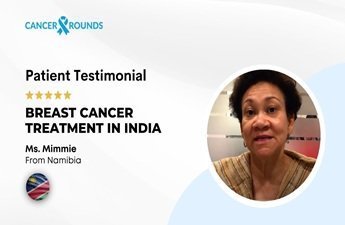
So grateful to Cancer Rounds and Dr. Sudip Raina for helping me through my breast cancer journey. I'm healing, hopeful, and feeling like myself again!
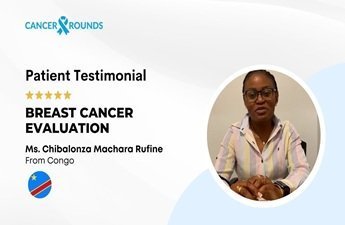
I was scared and uncertain, but Cancer Rounds helped me find answers. Thanks to their support and Dr. Arun Behl’s care in India, I found peace of mind—no cancer. Forever grateful for the kindness and clarity I received.
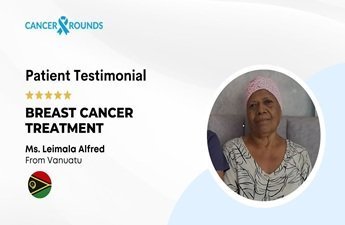
Thank you Cancer Rounds and Dr. Deepak Jha for your support and care during my breast cancer journey. I'm healing with hope because of you.
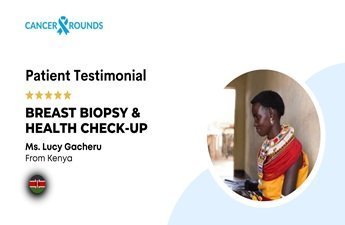
Cancer Rounds guided me to the right hospital. My breast tests came out fine. Thanks to Dr. Pandey, I now feel calm and healthy.
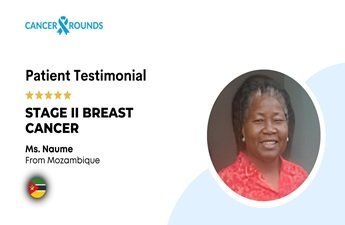
I'm deeply grateful to Dr. Kapil Kumar and BLK Max Hospital for helping me overcome Stage II breast cancer. Thanks to Cancer Rounds, I’m now cancer-free and thriving!

I had both breast cancer and diabetes. With Cancer Rounds and Dr. Rashmi Sharma’s care, I’m now free of cancer and feeling strong again.

I flew from Fiji to India for breast cancer care. Thanks to Cancer Rounds, Apollo Chennai, and Dr. Sapna Nangia, I returned home cancer-free.

From Namibia to India for breast cancer care — grateful to Dr. Sudip Raina & team at Batra Hospital for the support and treatment.
Our Impact
CancerRounds is making quality cancer care accessible to more people every day.




Why Choose India for Cancer Treatment?

World-Class Care
Skilled oncologists provide top-tier medical services

Affordable Treatment
Costs are significantly lower than in Western countries.

Comprehensive Packages
Hospitals offer all-inclusive plans covering surgery, stay, and aftercare.

Easy Accessibility
Well-connected airports and international flight routes.

Proven Success
High patient satisfaction and positive treatment outcomes
Thank You!
Your form has been submitted successfully.

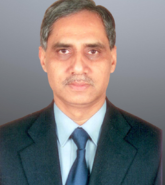

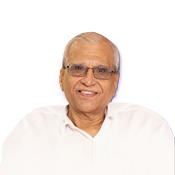

 Chat on WhatsApp
Chat on WhatsApp